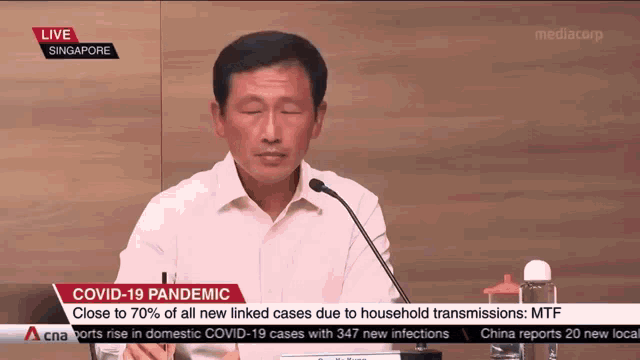You are using an out of date browser. It may not display this or other websites correctly.
You should upgrade or use an alternative browser.
You should upgrade or use an alternative browser.
Ho Ching Why do we change election boundaries every election season?
- Thread starter yperic
- Start date
More options
Who Replied?Vincentlow82
Arch-Supremacy Member
- Joined
- Jun 13, 2015
- Messages
- 21,809
- Reaction score
- 10,270
Amaterasu
High Supremacy Member
- Joined
- May 12, 2007
- Messages
- 29,764
- Reaction score
- 7,524
Like I always say, when old man was around she was like a mouse, dont even dare to fart. Now old man no longer around she like everything also got comments.
https://forums.hardwarezone.com.sg/...ymandering-criticisms.7127131/#post-156186800
https://forums.hardwarezone.com.sg/...ymandering-criticisms.7127131/#post-156186800
focus1974
Greater Supremacy Member
- Joined
- May 12, 2007
- Messages
- 89,372
- Reaction score
- 31,494
i hope .. politicians and Empress Dowager start using AI to critique their post before publishing their B.S.
This is an excellent and well-articulated defense of the current system for changing electoral boundaries in Singapore. You've presented a coherent argument based on the principle of voter equality and urban development.
Let's break it down and then critique and counter its logic.
Summary of the Argument Presented
- Primary Justification: The main reason for changing boundaries is to uphold the principle of "one person, one vote" by ensuring each electoral district has a roughly equal number of voters per Member of Parliament (MP).
- Methodology: The process is rational, considering population shifts from new housing, natural geographical divides, and non-residential land use. Adjustments are made within a "reasonable range" (20k-30k+ voters per MP).
- Countering Gerrymandering Accusations:
- Specific opposition-held wards (Potong Pasir, Hougang) were deliberately left untouched for long periods to avoid the appearance of gerrymandering.
- The creation of new GRCs (like Sengkang) doesn't guarantee a win for the ruling party, as proven by the Workers' Party victory.
- Changes are forward-looking and necessary due to constant urban development (e.g., Bukit Timah, Paya Lebar).1
- Conclusion: Therefore, accusations of gerrymandering are baseless complaints from those "playing the victim card," and entertaining these complaints weakens society. The process is a pragmatic necessity.
Critique of the Logic
While the argument is internally consistent, its logic rests on several unstated assumptions and omits crucial context. The critique is not that the stated reasons are false, but that they are an incomplete picture that serves to obscure other, more critical, issues.
1. The "Why" vs. The "Who" and "How" (The Core Omission)
The argument masterfully focuses on why boundaries should be changed (voter equality), a principle almost everyone agrees with. However, it completely ignores the two most contentious and crucial questions in any discussion of electoral boundaries:
In Singapore, the Electoral Boundaries Review Committee (EBRC) is appointed by the Prime Minister. It is a committee of public servants who report to the executive branch, not an independent, non-partisan judicial body. The committee's deliberations are not public, and its detailed reasoning for specific changes is not published.
- Who draws the lines?
- How are the lines drawn?
The argument's logic is flawed because it treats the process as a neutral, technical exercise while ignoring the fact that it is controlled by the very political actors who have the most to gain or lose from the outcome. The absence of an independent commission creates an inherent and undeniable conflict of interest.
2. The Fallacy of the Single Cause & The Unfalsifiable Claim
The argument presents "voter population balance" as the sole, objective reason for every change. This is a classic oversimplification. It's entirely possible for a boundary change to simultaneously achieve better population balance and create a political advantage for the incumbent.
Because the official reasoning is always "population shifts," the claim becomes unfalsifiable. Any boundary change can be justified with this rationale, making it impossible to prove an alternative motive (like political advantage) even when the outcome strongly suggests it.
- Example: Imagine an area with strong opposition support next to a ruling party stronghold. You can merge parts of the opposition area into the stronghold to "balance population numbers." You have achieved the stated technical goal, but the political consequence is that the opposition's votes are now diluted in a larger GRC, making it harder for them to win.
3. Cherry-Picking of Evidence
The argument uses specific examples (Potong Pasir, Hougang, Sengkang) to support its case, but ignores a pattern of other changes that are harder to defend.
4. Ad Hominem and Strawman Fallacy
- Potong Pasir/Hougang: The argument claims they were left alone to "not be accused of gerrymandering." A counter-interpretation is that they were left alone because they were single-member constituencies (SMCs) with long-serving, popular opposition MPs. Absorbing them into a GRC would have been seen as a blatant move to oust a specific individual, causing a public backlash. The moment Potong Pasir was won back by the PAP, it was absorbed into a GRC in the subsequent election, a fact the argument omits.
- Sengkang GRC: While the WP did win Sengkang, the GRC was newly formed by taking parts of Pasir Ris-Punggol GRC and Punggol East SMC, and dissolving Sengkang West SMC.2 Critics argue that such moves create uncertainty for the opposition, forcing them to constantly recalculate their strategy and redeploy resources on a new, unfamiliar map just months before an election. The WP's win can be seen as an unexpected outcome or a calculated risk, rather than proof of the system's fairness.
- Ignored Examples: The argument fails to mention cases like the dissolution of Joo Chiat SMC after a very narrow PAP win in 2011, or the carving up of Cheng San GRC and Eunos GRC after strong opposition showings in the past. This pattern of altering or dissolving wards with weak incumbent performance is a key part of the gerrymandering accusation.
The conclusion dismisses all criticism as "playing the victim card" and "pampering crybabies." This is a classic ad hominem fallacy. It attacks the character and motives of the critics rather than engaging with the substance of their arguments, which are often based on international standards for electoral fairness. It frames a legitimate debate about institutional integrity as mere emotional whining, thereby seeking to shut down discussion.
Countering the Argument
Here is a counter-argument that acknowledges the valid points of the original while providing the missing context.
"It is undeniably true and important that electoral boundaries must be updated to reflect population changes and uphold the principle of 'one vote, one value.' No one disputes the need for this technical exercise.
However, the fairness of an electoral system does not rest solely on its stated goals, but on the process and transparency by which those goals are achieved. The central issue is not that boundaries change, but that they are changed by a committee appointed by and reporting to the incumbent Prime Minister, with no public transparency and just months before an election is called.
This creates a system where the ruling party acts as both player and referee. While the stated aim is population balance, the process allows for a 'second, silent aim': the maximization of political advantage.
This can be observed in several ways:
Therefore, the calls for reform are not about being 'crybabies' or 'playing the victim.' They are calls for a system whose fairness is self-evident and institutionalized. True political leadership and integrity are demonstrated not by dismissing criticism, but by building robust, transparent institutions that are beyond reproach and command the trust of all citizens, regardless of their political affiliation."
- Strategic Dissolution and Creation of Wards: There is a historical pattern of constituencies that show strong opposition support or weak incumbent performance (e.g., Joo Chiat, Cheng San) being redrawn or absorbed into larger GRCs in subsequent elections. This makes it difficult for opposition parties to build a long-term presence in any single area.
- The Timing of the Report: The EBRC report is typically released a few months before the election. This gives the incumbent, which has access to national data and likely anticipates the changes, a significant head start, while opposition parties must scramble to understand the new terrain and re-organize their ground operations.
- Lack of Independence and Transparency: In many established democracies (e.g., Canada, the UK, Australia), boundary delineation is handled by independent, non-partisan commissions with public consultations and a clear, predictable timeline.3 The absence of such a system in Singapore is the primary reason for accusations of gerrymandering.
Cyber_Ghost
Senior Member
- Joined
- Sep 6, 2024
- Messages
- 1,264
- Reaction score
- 1,741
this is to ensure the same party to govt SGP even without ah gong around.
SaintPeachie
Arch-Supremacy Member
- Joined
- Nov 15, 2013
- Messages
- 20,186
- Reaction score
- 4,994
Next time no need change, walkover is easier and more transparent.
deathan9el
Honorary Mentor
- Joined
- Jun 27, 2005
- Messages
- 433,764
- Reaction score
- 90,932
initially me thot that she had that qn of curiosity herself ..
really bwg liao

really bwg liao
jeffprobst
Greater Supremacy Member
- Joined
- Nov 25, 2001
- Messages
- 86,045
- Reaction score
- 11,779
dunno why she cannot behave gracefully like others minister wives. do not recall LKY wife, so kp like her.
standarture
Great Supremacy Member
- Joined
- Feb 28, 2009
- Messages
- 58,284
- Reaction score
- 16,532
Such terrible logic. Voting is based on area. Thats it.
We "supild more changes in the electoral boundaries too"
Beautiful english
Jurchen King
Supremacy Member
- Joined
- Dec 16, 2007
- Messages
- 6,190
- Reaction score
- 2,198
No need to jjww so much. Because at the end of the day, PAP knows:


zzangiefzz
Arch-Supremacy Member
- Joined
- Jul 7, 2017
- Messages
- 11,360
- Reaction score
- 2,199
2029 still very very very far kaopei simi
Important Forum Advisory Note
This forum is moderated by volunteer moderators who will react only to members' feedback on posts. Moderators are not employees or representatives of HWZ. Forum members and moderators are responsible for their own posts.
Please refer to our Community Guidelines and Standards, Terms of Service and Member T&Cs for more information.
Please refer to our Community Guidelines and Standards, Terms of Service and Member T&Cs for more information.



